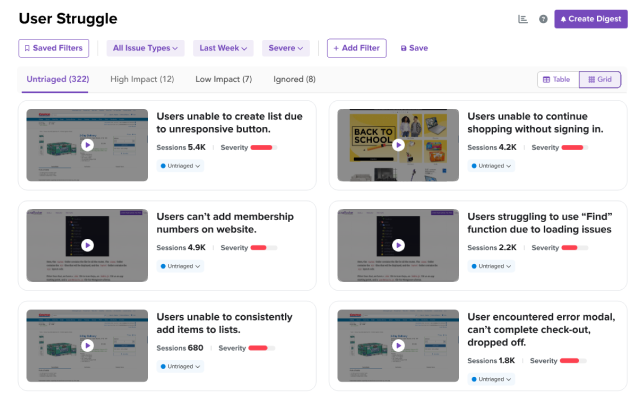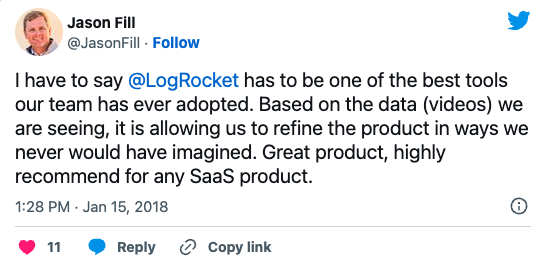- 1. Executive summary
- 2. Project objective
- 3. Deliverables
- 4. Scope boundaries
- 5. Timeline and milestones
- 6. Resources
- 7. Dependencies

LogRocket’s Galileo AI watches every session, surfacing impactful user struggle and key behavior patterns.
Protecting resources and avoiding scope creep is among the most important missions of a product manager, and there are myriad tools and techniques to help you do so. One such technique is writing a scope of work (SOW).

A scope of work serves as a roadmap for a given project or product initiative. Documenting the scope of work also helps product managers establish expectations and minimize misunderstandings by ensuring alignment among stakeholders.
In this article, we’ll define what scope of the work means in detail and provide a template to help you write a SOW documents to get all your stakeholders on the same page.
What is a scope of work (SOW)?
A scope of work is a comprehensive, project-based document that outlines the objectives, deliverables, and boundaries of a product development project. It serves as a reference and baseline document for all stakeholders involved in this new strategic move, including product managers, development teams, designers, and other key parties.
The scope of work is limited to new, big initiatives and strategic moves that require building a comprehensive set of features or a completely new product. It is not meant for small features and improvements.
The SOW document provides an in-depth overview of the product’s business objective, goals, and outcomes the team expects to achieve by introducing the product. It helps product managers define the scope and boundaries of the product by identifying the features that are included and excluded in a high-level manner. The SOW document also helps ensure that all stakeholders involved in the value creation process are aligned on what exactly the product team plans to build and by when.
The scope of work is a very business-oriented document. Thus, it should communicate the strategic business move in a very easy, nontechnical, and straightforward way.
Scope of work vs. work statement
The scope of work is an abstract view of the project. It contains a holistic view of the project, starting from the project objective and definition all the way to deliverables.
The statement of work, on the other hand, is a lower-level document. It describes the work to be undertaken for a specific task in the project.
The table below summarizes the difference between the two documents:
| Characteristic | Scope of work (SOW) | Work statement |
|---|---|---|
| Definition | A document that describes the project scope and the work that will be done throughout the project | A descriptive document that outlines the work that will be performed in a specific project task |
| Perspective | Focuses on the “what” by highlighting the desired outcome along with the high-level requirement | Focuses on the “how” by specifying actions, certain actions, and requirements to be implemented |
| Purpose | Ensures that all team members across all departments are on the same page about what needs to be done for the projec | Detailed team based/ individual-based plan for one or more project tasks |
| Content | Project goal, project objective, work to be done, deliverables, out-of-scope items, project schedule, project risks, and project team members | Includes description of the specific task, the owner who will execute the tasks, dependencies between tasks, and risk associated with them |
| Depth | High-level document with an overview of the project scope and the actions needed to reach the project goals | Deep on the task level. Included a step-by-step plan for that specific task |
| Usage | Used to communicate with stakeholders to ensure that everyone is on the same page. Used more as a contractual document | Used to guide the project team (the team who will be responsible for implementing the project) and to track the progress of the projec |
Scope of work template
The preferred approach to documenting a scope of work varies from organization to organization. The template below serves as a good, intuitive starting point for writing a SOW document for your major product initiative or project.

Over 200k developers and product managers use LogRocket to create better digital experiences
![]()
Learn more →
We’ll demonstrate how to fill out the scope of work template using an example of developing a fitness mobile app.
1. Executive summary
In this section, you will describe briefly what is included in the document and outline the project in an abstract manner.
This scope of work document outlines the objectives, deliverables, and scope boundaries of developing our first fitness mobile app. The app is designed for trainers to offer their services online and get clients. The app will take three months of development, and we will include features 1, 2, and 3 in our initial release.
2. Project objective
In this section, you will talk about the business objective behind building the project and why it is essential for the overall organization’s mission, vision, and goals.
The objective of the project is to develop a mobile app for fitness trainers that can be the first in the region. The app will generate +$xxx in revenue each month and will allow us to sign more strategic partners.
3. Deliverables
This is by far the core section of the document. You will here list all features that will be delivered under this project’s scope, along with their tasks.
For us to mark this project successful, here is what we will deliver:
- Fully functional fitness mobile application compatible with iOS and Android platforms.
- Feature 1: The trainer will be able to create a profile
- Feature 2: The trainer will be able to set prices
Note: By stating “fully functional,” you avoid adding obvious tasks, like the creation of wireframes and building the frontend and the backend of the product.
4. Scope boundaries
This is your chance to protect your resources. This section is mainly driven by past stakeholder conversations during the requirement collection and analysis.
More great articles from LogRocket:
- How to implement issue management to improve your product
- 8 ways to reduce cycle time and build a better product
- What is a PERT chart and how to make one
- Discover how to use behavioral analytics to create a great product experience
- Explore six tried and true product management frameworks you should know
- Advisory boards aren’t just for executives. Join LogRocket’s Content Advisory Board. You’ll help inform the type of content we create and get access to exclusive meetups, social accreditation, and swag.
In our initial release, we will exclude the following:
- Feature 1 — Payment using PayPal
- Feature 2 — Annual Subscription for trainers
5. Timeline and milestones
This can be your typical project plan section. In this section, you will provide the required time needed for each task and feature associated with the project.
- Phase 1 — Product discovery (2 weeks)
- Phase 2 — Requirement analysis (1 week)
- Phase 3 — Initial development (4 weeks), features included:
- Feature 1
- Feature 2
- Feature 3
- Phase 4 — Second round of dev (3 weeks)
- Feature 4
- Feature 5
- Phase 5 — Beta program (4 months)
6. Resources
In this section, list all team members needed for this project, along with a high-level overview of their roles regarding the project.
- Product manager — Overseas the product development process and prioritize features
- 3x backend engineers — To build the database and servers for our product
- UX designer — To create the prototypes and design system of our product
7. Dependencies
In this section, define which any other stakeholders who need to be accountable. This section is your chance to communicate any needed support from their side. Do you need a marketing launch plan? Include it here. Or do you need the user manuals to be created by the CX team? Communicate it here. If these dependencies are not resolved or executed before the end of the project, the project might face a serious chance of failing.
| Dependencies tasks | Assigned team | Deliverable |
|---|---|---|
| Create the launch plan for the mobile app | Product marketing team | Launch plan |
| Create a market testing plan | Product team | Market testing plan |
Final words
In conclusion, developing a comprehensive scope of work is an essential element of effective project management. The scope of work for product and project teams serves as a guiding document, delineating the project’s business objectives, deliverables, and scope boundaries. Through its clear articulation of the “what” and “how” of the project, it establishes expectations, minimizes misunderstandings, reduces the risk of scope creep, and fosters harmonious collaboration among all stakeholders.
It is important to know that the scope of work extends beyond a mere contractual formality; it is a dynamic tool that facilitates seamless communication and collaboration between all stakeholders. As a product manager or project manager, dedicating adequate time and effort to craft a detailed and well-structured scope of work yields long-term dividends. It empowers smoother project execution and elevates the probability of achieving favorable outcomes.
In summary, always bear in mind that the scope of work is more than a static document; it is a catalyst for effective teamwork and successful project delivery. Therefore, invest in the meticulous development of a comprehensive scope of work as a cornerstone for your endeavors, paving the way for seamless execution and better business outcome.
LogRocket generates product insights that lead to meaningful action
LogRocket identifies friction points in the user experience so you can make informed decisions about product and design changes that must happen to hit your goals.
With LogRocket, you can understand the scope of the issues affecting your product and prioritize the changes that need to be made. LogRocket simplifies workflows by allowing Engineering, Product, UX, and Design teams to work from the same data as you, eliminating any confusion about what needs to be done.
Get your teams on the same page — try LogRocket today.
Share this:
- Click to share on Twitter (Opens in new window)
- Click to share on Reddit (Opens in new window)
- Click to share on LinkedIn (Opens in new window)
- Click to share on Facebook (Opens in new window)